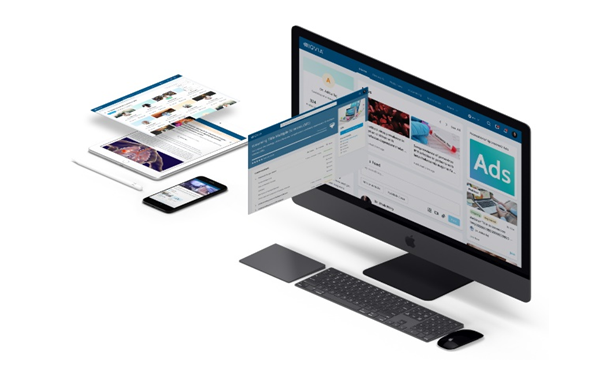Build and nurture valued relationships


































- Locations
- Middle East & Africa
- Digital engagement in healthcare: The rise of digital communication trends and requirements for success
The empowered and influential consumer is on the rise. Over recent years, consumers have dominated online platforms, featuring organisations, brands, products, and household names. Due to the wide adoption of digital technology and the resulting rise of connected and informed consumers, the move towards a consumer-centric digital engagement model plays an important role in the visibility and reputation of healthcare providers (HCPs).
Digital transformation has impacted numerous industries, including healthcare. In recent years, especially since the COVID-19 pandemic, it has become crucial for healthcare stakeholders to place the desires and concerns of patients at the centre of every healthcare decision. This shift is demanding HCPs to not only review digital solutions for treatment of patients, but also to shift their mindset from traditional engagement methods (such as face-to-face consultations, paper-based notes, printed journals), to serving patients in the best possible way.
One survey conducted among General Practitioners in South Africa, indicated that:
- Just over 60% of HCPs experienced an increase in digital demand in their network over the last three years.
- Furthermore, 65% of HCPs are open to use more digital channels and applications, in their professional capacity, in the future. Although some HCPs indicated they do not have the capacity to adopt new systems or technologies, the key driver for digital use in healthcare is the contribution to increased productivity.
- Although the demand for digital is rising, 53% of HCPs are still only conducting face-to-face consultations, 48% of them do not utilize social media platforms in a professional capacity, and 66% of HCPs ranked the use of traditional channels such as paper-based notes, telephone calls and face-to-face consultations as their top 3 most used channels in their practice.
According to the World Health Organization (WHO), quality healthcare can be defined in many ways, but rests on three core pillars:
- Effective care
- Safe treatment
- People-centred attention
People or patient-centred attention is understanding patient needs, embracing differences, and enhancing your services and value through patient-specific tailored care. However, digital engagement goes beyond communicating with your patients through digital platforms relevant to them, it is about forming connections with people, growing patient access, making an impact – all whilst increasing your efficiency.

How organisations interpret digital engagement or act on the concept of digital transformation will vary but having a clear understanding of what a digital strategy involves, will allow business leaders to develop a shared vision of how it can be used to capture value.
The concept and meaning of digital differ across industries and people. Digital as a term does not refer to a thing, a process, nor a solution, and it is not merely an adjective. The term digital means to re-examine your way of doing business and understand where the new frontiers of value are. However, it also means to rethink how to use new capabilities to improve how patients are served and implementing technological and organisational processes that allow a business to be agile and operate in a fast-paced environment.
Your digital strategy could consist of many components such as people, processes, tools, marketing, but one of these components should be engagement. Often overlooked, communication management is becoming more important and plays a key role in a patient-centred environment. Your digital engagement strategy outlines how your business intentionally chooses to position itself online.
What role does digital transformation play in the healthcare industry?
Although the healthcare and pharmaceutical industry is complex and slow to adopt digital as part of their strategy, we noticed a big change in consumer behaviour related to digital:

Patients are managing their illnesses prior to disease diagnosis by leveraging social media, online communities, blogs, forums, and mobile apps to build disease understanding, and to support their diagnosis.
Key factors in successful digital engagement
Many business concerns and questions can be answered with data. Research data that reviews the behaviours of your target patients, their perceptions, attitudes, and motivations, will give you a foundation to create an impactful message. However, to reach the core universal truths that make a message resonate, it means turning the data into insights.
1. Look at your audience segments and identify channel preferences
Just as different physicians engage more purposefully through various kinds of communication channels, patients respond differently based on the engagement platform. Who are your audience or patient groups, and what is important to them?
The three most commonly used channels HCPs use to engage with patients post-consultation are telephonic conversations (47%), followed by emails (42%) and then WhatsApp (36%).
Understanding what will be of value to different patient and HCP segments can assist you in developing tailored messages and solutions to help patients stay adherent to treatments and improve health outcomes.
2. Construct your content and messaging
To create a message that converts, you need to think patient-first. More importantly, ensure your messages are clear, concise, and effective to the intended audience. Tune into your patients’ or HCPs’ world to find out what matters to them most, and how this may impact their engagement habits.

3. Create a sustainable engagement model
Testing the digital industry, we see some organisations testing one or two platforms while others are experimenting with a wide range of digital initiatives. No matter which form of digital engagement you choose to focus on, the key is to refocus your communication strategies to create a patient-centric approach and discover new ways to maximize digital engagement.
Establish a pattern of success and proven, reliable solutions. In short, define what works and what doesn’t. But instead of focussing on a single traditional channel, follow an omnichannel approach.
What is an omnichannel approach?
The term ‘omnichannel’ refers to a multichannel approach to engagement, providing patients with a custom, seamless communication experience.
Based on HCP and patient channel preferences, available technologies, and internal resources, review your mix of content and channels, with the goal of offering HCPs access to information where, when, and how they want it. More importantly, continue measuring the impact of your engagement efforts to optimize your engagement model.

The fast-paced development of the digital space and its ever-growing importance has a large-scale impact across organisations and industries. Engaging digitally with HCPs and patients based on their preferences is forward-looking, personal, and it should be people-centric and innovative.
It is time to rethink engagement!
IQVIA is a leader in digital solutions that deliver successful digital engagements between providers and patients. Contact us to learn more.
Related solutions
Transform decision-making with purpose-built innovation
